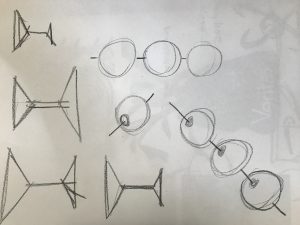/*
Connor McGaffin
Section C
cmcgaffi@andrew.cmu.edu
Project-05
*/
var ang = 120;
function setup() {
createCanvas(600, 400);
background(80,50,0);
noStroke();
//olive
for(x=0; x<width; x+=50){
for(j=0; j<height; j+=50){
fill(100,70,0);
ellipse(x+25,j+25,50,50);
}
}
//pits
for(x=0; x< width+50; x+=50){
for(y=0; y<height; y+=50){
stroke(60,0,0);
strokeWeight(2);
fill(85,0,0);
ellipse (x-35, y+15, 15,15);
}
}
//skewers
for(x=0; x< width; x+=50){
for(y=0; y<height; y+=50){
fill(100,0,0);
stroke(50,0,0);
strokeWeight(2);
line(x-7,y-7,x+15,y+15);
}
}
//glass
for(x=0; x<width; x+=100){
for(y=0; y<width; y+=100){
noStroke();
fill('rgba(250, 250, 250, 0.6)');
triangle(x+10,y+10,x+80,y+10,x+45,y+35);
rect(x+42.5,y+33,5,45);
triangle(x+10,y+10,x+80,y+10,x+45,y+35);
triangle(x+20,y+83,x+70,y+83,x+45,y+75);
}
}
}
I created this pattern after being inspired by the art deco visuals of AMC’s “Mad Men”. I had fun finding a way to visualize the olives while still speaking to the visual aesthetic of the 1960’s era. Initially, I approached the olives in an projected view, but they were indistinguishable from everyday beads. When rotating the olives to a 3/4 view from above, an interesting sense of space is established. The choice to connect all of the olives on the same skewer creates a surreal atmosphere to the environment, which speaks to the inability to place where this pattern is located when viewed on a screen.
I would anticipate that this pattern could potentially be used in a restaurant. It’s fun but also a little gaudy, so it would likely go in there bathroom, rather than the front lobby.
![[OLD FALL 2018] 15-104 • Introduction to Computing for Creative Practice](wp-content/uploads/2020/08/stop-banner.png)
